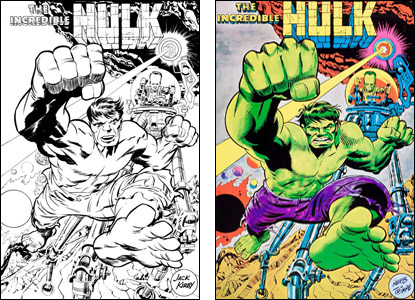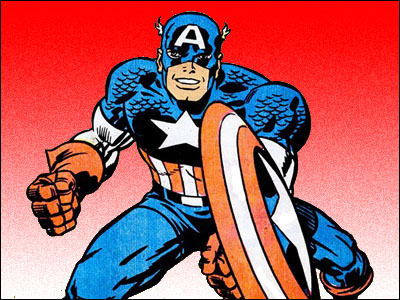The current issue of Art in America magazine contains an article on Jack Kirby entitled, "Genius in a Box." The piece was written by Alexi Worth and an intro paragraph says…
A legend among comics fans, Jack Kirby was the gifted, overworked illustrator who made Marvel Comics possible. Two recent exhibitions reveal his artwork as an inventive "side-channel" within pictorial modernism.
I agree with all that and appreciate this appreciation of Kirby but I have a few small quibbles, one being Worth's doubt that Jack anticipated his own immortality as an artist. He's wrong. Jack, in a surprisingly non-egotistical way, talked often of how his work would outlive him…as would the work of other great comic creators. He absolutely expected it to be reprinted in editions with deluxe printing and to be exhibited in galleries.
Also, there is the assertion that Jack's new books for DC in the early seventies "flopped." They were canceled prematurely by a company that was crumbling from all corners at the time and had to be rebuilt, almost from the ground up, a few years later. New management looked at the sales figures for the books Worth says "flopped" and promptly revived and reprinted them…and they continue to reprint them over and over and to reuse the characters and concepts introduced in them. I would save the word "flop" for something that went away and was never seen again.

And I guess I oughta take issue with what Worth writes about a Hulk poster that Kirby drew and which was then redrawn somewhat by Herb Trimpe…
As his friend and biographer Mark Evanier tells it, "someone at Marvel" evidently decided that Kirby's Hulk poster was too eccentric. Another artist, Herb Trimpe, was assigned to lightly deKirbify the poster, giving the Hulk ordinary knuckles and fingernails, normal feet and recognizable pectorals.
That's not what his friend and biographer Mark Evanier said. What I said in my first book on Jack was…
…someone at Marvel decided that the proposed line [of posters] had too much Kirby in it and ordered that four of Jack's posters be replaced by the work of other artists…[they] liked the design of Jack's Hulk poster. They just felt it should be illustrated by Herb Trimpe, who was then the artist on the Hulk comic. Trimpe was told to trace Kirby's drawing, which he did, effectively just re-inking it and altering the head as per his version of the character.
I never said it was deemed too eccentric, nor was Trimpe told to change the knuckles, fingernails, etc. The alterations were almost all of the character's head and any other changes were just Trimpe doing things the way Trimpe did. Worth also deduces that the exaggerated pose related somehow to the one 3-D comic Jack had drawn more than a decade earlier — which of course it didn't. Jack's super-hero work was always filled with that kind of extreme pose, dating back to before he first drew Captain America.
I cringed at Worth's description of Kirby as a "hack" — but then I always cringe at that word, especially when applied to someone of earnest intent who was giving his employer way more than he had to in order to get the paycheck in question. It's a word that in 50-some-odd years of reading comic book reviews and essays, I have seen applied in a myriad of ways ranging from a compliment for sheer productivity to a synonym for "knowing producer of crap." I'm sure Worth wasn't using the latter definition but to Jack, during a period of his career when detractors were calling him "Jack the Hack," it was the supreme insult, condemning not only the work but the integrity of its maker.
Also: The article identifies Fantastic Four #76 as coming out in 1975. Perhaps a reprint of the story in it did but the original publication was in 1968. And I think that's about all that bothered me: Not all that much and not at all the central thesis.

I hope I'm not being too negative about a piece that I am quite glad was published where it was published. Jack's work deserves recognition from all quarters and I'm glad Worth talked about it as sequential art. Too often, people approach Jack as an illustrator and liken his individual pages and panels to works of art meant to be complete in themselves. Jack was an illustrator and yet again, he wasn't. To get the "big picture" (to use a term he used often), you have to view him as a storyteller if not a writer.
That was the only way Jack viewed his work: Not whether he'd done a good drawing but whether he'd done the right drawing. To him, if it conveyed what he wanted the panel to convey, it was a good drawing. When I spoke at the wonderful, recent exhibit of Jack's work out at Cal State Northridge, I tried to make the point that to fully appreciate and comprehend his work, you have to consider the art in the context of its intention.
Which doesn't mean you can't hang Jack in galleries and discuss him in the same breath as guys who unquestionably belong there. It just means that in addition to looking at panels or pages, you ought to read the comic. I hope pieces like Worth's will prompt more people to do both those things.